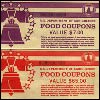The second unit of the course introduces you to the analysis of consumer behavior. The decisions that individuals make about what and how much to consume are among the most important factors that shape the evolution of the overall economy, and we can analyze these decisions in terms of their underlying preferences. You will learn how to model consumer preferences in a utility function, and use this utility function to make predictions about what consumers will do when they have a given income and can buy goods at a given price. You will also learn how to analyze the decision of whether and how much individuals choose to work.

|
Image courtesy of William Jones on Flickr. |
|
|
Image courtesy of allison.johnston on Flickr |
|
|
Image courtesy of Brian on Flickr. |
|
|
Applying Consumer Theory: Labor Image courtesy of Joi Ito on Flickr. |













